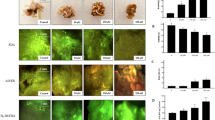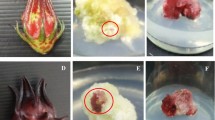Abstract
Jatropha curcas has significant potential for production of biodiesel and secondary metabolites with medical applications. The effect of jasmonic acid (JA) on flavonoid production and antioxidant responses in two Mexican J. curcas plants (accessions I-64 and I-52), growing under controlled environmental conditions, was studied. Foliar application of JA (0.25, 0.5, and 1.0 mM) increased flavonoid content by 3.3-fold (445.6 ± 62.2 µg QE g−1 DW) at 1.0 mM in the I-64 accession after 120 h. At this time, individual flavonoid levels of kaempferol, apigenin, and vitexin were 6.8 (106.8 ± 18.6 µg g−1 DW), 4.4 (15.5 ± 1.5 µg g−1 DW), and 8.1 (6.27 ± 1.3 µg g−1 DW) times higher than in the controls, while for the I-52 specimens, the highest increase of flavonoids occurred at 24 h. In treated I-52 plants, enhancement of 58% (74.7 ± 9.2 µg g−1 DW) in anthocyanins occurred after 120 h, while in I-64 plants, they remained similar to controls. Phenylalanine ammonia lyase showed a peak of activity after 120 h in treated I-64 plants, while the I-52 accession showed peaks at 24 and 120 h. Elicited I-64 plants presented H2O2 levels similar to controls with a 30.6% increase in catalase (CAT) and 3.3-fold in ascorbate peroxidase (APX) activities. In elicited I-52 plants, a 2.4-fold increase in H2O2 concentration was related to a 65.6% decrease of CAT and a 1.8-fold increase of APX activities. Therefore, under JA elicitation, J. curcas plants increased antioxidant responses including flavonoid and anthocyanin production to maintain cell redox balance.





Similar content being viewed by others
References
Aebi H (1984) Catalase in vitro. Methods Enzymol 105:121–126
Agati G, Azzarello E, Pollastri S, Tattini M (2012) Flavonoids as antioxidants in plants: location and functional significance. Plant Sci 196:67–76
Ali MB, Hahn EJ, Paek KY (2007) Methyl jasmonate and salicylic acid induced oxidative stress and accumulation of phenolics in Panax ginseng bioreactor root suspension cultures. Molecules 12:607–621
Alvero-Bascos EM, Ungson LB (2012) Ultraviolet-B (UV-B) radiation as an elicitor of flavonoid production in callus cultures of Jatropha (Jatropha curcas L.). Philipp Agric Sci 95:335–343
Baudouin E, Charpenteau M, Ranjeva R, Ranty B (1999) Involvement of active oxygen species in the regulation of a tobacco defence gene by phorbol ester. Plant Sci 142:67–72
Baudouin E, Charpenteau M, Ranjeva R, Ranty B (2002) A 45-kDa protein kinase related to mitogen-activated protein kinase is activated in tobacco cells treated with a phorbol ester. Planta 214:400–405
Chang CC, Yang MH, Wen HM, Chern JC (2002) Estimation of total flavonoid content in propolis by two complementary colorimetric methods. J Food Drug Anal 10:178–182
De Geyter N, Gholami A, Goormachtig S, Goossens A (2012) Transcriptional machineries in jasmonate-elicited plant secondary metabolism. Trends Plant Sci 17:349–359
de la Peña MF, Blanch GP, Ruiz del Castillo ML (2010) (+)-Methyl jasmonate-induced bioformation of myricetin, quercetin and kaempferol in red raspberries. J Agric Food Chem 58:11639–11644
Erhard D, Pohnert G, Gross EM (2007) Chemical defense in Elodea nuttalli reduces feeding and growth of aquatic herbivorous Lepidoptera. J Chem Ecol 33:1646–1661
Falcone-Ferreyra ML, Rius SP, Casti P (2012) Flavonoids: biosynthesis, biological functions and biotechnological applications. Front Plant Sci 3:1–12
Flores-Sanchez IJ, Verpoorte R (2008) PKS activities and biosynthesis of cannabinoids and flavonoids in Cannabis sativa L. plants. Plant Cell Physiol 49:1767–1782
Franceschi VR, Grimes HD (1991) Induction of soybean vegetative storage proteins and anthocyanins by low-level atmospheric methyl jasmonate. Proc Natl Acad Sci USA 88:6745–6749
Gao J, Zhang S, Cai F, Zheng X, Lin N, Quin X, Ou Y, Gu X, Zhu X, Xu Y, Chen F (2012) Characterization and expression profile of a phenylalanine ammonia lyase gene from Jatropha curcas L. Mol Biol Rep 39:3443–3452
Giberti S, Bertea CM, Narayana R, Maffei ME, Forlani G (2012) Two phenylalanine ammonia lyase isoforms are involved in the elicitor-induced response of rice to the fungal pathogen Magnaporthe oryzae. J Plant Physiol 169:249–254
Gou JY, Felippes FF, Liu CJ, Weigel D, Wang JW (2011) Negative regulation of anthocyanin biosynthesis in Arabidopsis by a miR156-targeted SPL transcription factor. Plant Cell 23:1512–1522
Gundlach H, Muller MJ, Kutchan TM, Zenk MH (1992) Jasmonic acid is a signal transducer in elicitor-induced plant cell cultures. Proc Natl Acad Sci USA 89:2389–2393
Hahlbrock K, Ragg H (1975) Light-induced changes of enzyme activities in parsley cell suspension cultures: effects of inhibitors of RNA and protein synthesis. Arch Biochem Biophys 166:41–46
Hendrawati O, Yao Q, Kim HK, Linthorst HJM, Erkelens C, Lefeber AWM, Choi YH, Verpoorte R (2006) Metabolic differentiation of Arabidopsis treated with methyl jasmonate using nuclear magnetic resonance spectroscopy. Plant Sci 170:1118–1124
Horbowicz M, Wiczkowski W, Koczkodaj D, Saniewski M (2011) Effects of methyl jasmonate on accumulation of flavonoids in seedling of common buckwheat (Fagopyrum esculentum Moench). Acta Biol Hung 62:265–278
Krcatović E, Rusak G, Bezić N, Krajacić M (2008) Inhibition of tobacco mosaic virus infection by quercetin and isovitexin. Acta Virol 52:119–124
Kumar S, Pandey AK (2013) Chemistry and biological activities of flavonoids: an overview. Sci World J. doi:10.1155/2013/162750
Kumar A, Sharma S (2008) An evaluation of multipurpose oil seed crop for industrial use (Jatropha curcas L.): a review. Ind Crop Prod 28:1–10
Kurosaki F, Tsurusawa Y, Nishi A (1987) Breakdown of phosphatidylinositol during the elicitation of phytoalexin production in cultured carrot cells. Plant Physiol 85:601–604
Liu W, Zu Y-G, Fu Y-J, Kong Y, Ma W, Yang M, Li J, Wu N (2010) Variations in contents of phenolic compounds during growth and post-harvest storage of pigeon pea seedlings. Food Chem 121:732–739
Mahady GB, Liu C, Beecher CWW (1998) Involvement of protein kinase and G proteins in the signal transduction of benzophenanthridine alkaloid biosynthesis. Phytochemistry 48:93–102
Martinez-Herrera J, Martinez-Ayala AL, Makkar H, Francis G, Becker K (2010) Agroclimatic conditions, chemical and nutritional characterization of different provenances of Jatropha curcas L. from México. Eur J Sci Res 39:396–407
Mhamdi A, Queval G, Chaouch S, Vanderauwera S, Breusegem FV, Noctor G (2010) Catalase function in plants: a focus on Arabidopsis mutants as stress-mimic models. J Exp Bot 61:4197–4220
Mierziak J, Wojtasik W, Kostyn K, Czuj T, Szopa J, Kulma A (2014) Crossbreeding of transgenic flax plants overproducing flavonoids and glucosyltransferase results in progeny of improved antifungal and antioxidative properties. Mol Breeding 34:1917–1932
Onkokesung N, Reichelt M, Van Doorn A, Schuurink RC, van Loon JJ, Dicke M (2014) Modulation of flavonoids metabolites in Arabidopsis through overexpression of the MYB75 transcription factor: role of kaempferol-3,7-dirhamnoside in resistance to the specialist insect herbivore Pieris brassicae. J Exp Bot 65:2203–2217
Orozco-Cárdenas ML, Narváez-Vásquez J, Ryan CA (2001) Hydrogen peroxide acts as a second messenger for the induction of defense genes in tomato plants in response to wounding, systemin, and methyl jasmonate. Plant Cell 13:179–191
Peterson GL (1977) A simplification of the protein assay method of Lowry et al. which is more generally applicable. Anal Biochem 83:346–356
Prasad DMR, Izam A, Khan MMR (2012) Jatropha curcas: plant medical benefits. J Med Plants Res 6:2691–2699
Salvador-Figueroa M, Magaña-Ramos J, Vázquez-Ovando JA, Adriano-Anaya ML, Ovando-Medina I (2015) Genetic diversity and structure of Jatropha curcas L. in its center of origin. Plant Genet Resour 13:9–17
Sasaki-Sekimoto Y, Taki N, Obayashi T, Aono M, Matsumoto F, Sakurai N, Suzuki H, Hirai MY, Noji M, Saito K, Masuda T, Takamiya K, Shibata D, Ohta H (2005) Coordinated activation of metabolic pathways for antioxidants and defense compounds by jasmonates and their roles in stress tolerance in Arabidopsis. Plant J 44:653–668
Sergiev I, Alexieva V, Karanov E (1997) Effect of spermine, atrazine and combination between them on some endogenous protective systems and stress markers in plants. Proc Bulg Acad Sci 51:121–124
Shan X, Zhang Y, Peng W, Wang Z, Xie D (2009) Molecular mechanism for jasmonate-induction of anthocyanin accumulation in Arabidopsis. J Exp Bot 60:3849–3860
Shigeoka S, Ishikawa T, Tamoi M, Miyagawa Y, Takeda T, Yabuta Y, Yoshimura K (2002) Regulation and function of ascorbate peroxidase isoenzymes. J Exp Bot 53:1305–1319
Silva EN, Ferreira-Silva SL, Fontenele AV, Ribeiro RV, Viégas RA, Silveira JAG (2010) Photosynthetic changes and protective mechanisms against oxidative damage subjected to isolated and combined drought and heat stresses in Jatropha curcas plants. J Plant Physiol 167:1157–1164
Velikova V, Yordanov I, Edreva A (2000) Oxidative stress and some antioxidant systems in acid rain-treated bean plants. Protective role of exogenous polyamines. Plant Sci 151:59–66
Wasternack C, Hause B (2013) Jasmonates: biosynthesis, perception, signal transduction and action in plant stress response, growth and development. An update to the 2007 review in Annals of Botany. Ann Bot 111:1021–1058
Winkel-Shirley B (2002) Biosynthesis of flavonoids and effects of stress. Curr Opin Plant Biol 5:218–223
Xia XJ, Zhou YH, Shi K, Zhou J, Foyer CH, Yu JQ (2015) Interplay between reactive oxygen species and hormones in the control of plant development and stress tolerance. J Exp Bot 66:2839–2856
Zaragoza-Martínez F, Lucho-Constantino GG, Ponce-Noyola T, Esparza-García F, Poggi-Varaldo H, Cerda-García-Rojas CM, Trejo-Tapia G, Ramos-Valdivia AC (2016) Jasmonic acid stimulates the oxidative responses and triterpene production in Jatropha curcas cell suspension cultures through mevalonate as biosynthetic precursor. Plant Cell Tiss Org Cult 127:47–56
Zavala del Angel I, García-Pérez E, González Hernández D, Pérez Vázquez A, Ávila Reséndiz C (2016) Genetic diversity of Jatropha curcas L. in Veracruz state, Mexico, and its relationships with the content of phorbol esters. Glo Adv Res J Agric Sci 5:149–158
Zhang X, Liu CJ (2015) Multifaceted regulations of gateway enzyme phenylalanine ammonia-lyase in the biosynthesis of phenylpropanoids. Mol Plant 8:17–27
Zhang Z, Guo X, Liu B, Tang L, Chen F (2011) Genetic diversity and genetic relationship of Jatropha curcas between China and Southeast Asian revealed by amplified fragment length polymorphisms. Afr J Biotech 10:2825–2832
Zhang L, Zhang C, Wu P, Chen Y, Li M, Jiang H, Wu G (2014) Global analysis of gene expression profiles in physic nut (Jatropha curcas L.) seedlings exposed to salt stress. PLoS ONE 9:e97878. doi:10.1371/journal.pone.0097878
Zimmerman A, Hahlbrock K (1975) Light induced changes in enzyme activities in parsley cell suspension. Purification and some properties of phenylalanine ammonia-lyase. Arch Biochem Biophys 166:54–62
Acknowledgments
This work was supported by CINVESTAV-IPN and CONACYT-Mexico (Grant 222097). GGLC acknowledges CONACYT-Mexico for a doctoral fellowship (52756). Authors wish to thank Dr. Gabriela Luna-Palencia for her advice in chromatographic analysis and Carmen Fontaine for technical support. We are grateful to Drs. Arturo Pérez Vázquez, Eliseo García-Pérez and Ivan Zavala del Angel for donation of seeds from the Germplasm Bank of Colegio de Postgraduados, Campus Veracruz.
Author information
Authors and Affiliations
Corresponding author
Additional information
Communicated by H. Peng.
Electronic supplementary material
Below is the link to the electronic supplementary material.
Rights and permissions
About this article
Cite this article
Lucho-Constantino, G.G., Zaragoza-Martínez, F., Ponce-Noyola, T. et al. Antioxidant responses under jasmonic acid elicitation comprise enhanced production of flavonoids and anthocyanins in Jatropha curcas leaves. Acta Physiol Plant 39, 165 (2017). https://doi.org/10.1007/s11738-017-2461-2
Received:
Revised:
Accepted:
Published:
DOI: https://doi.org/10.1007/s11738-017-2461-2




